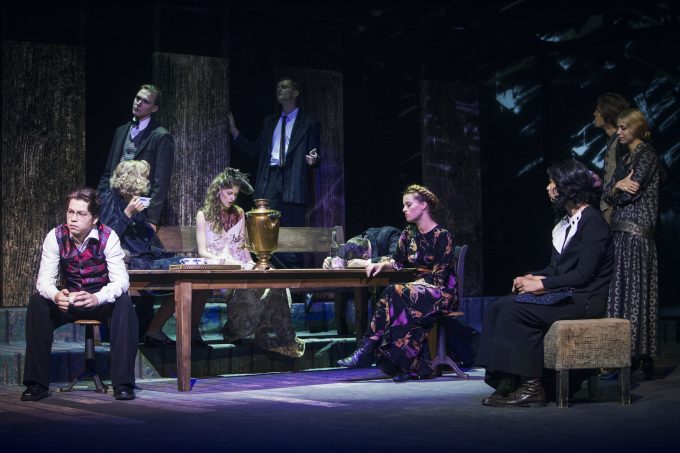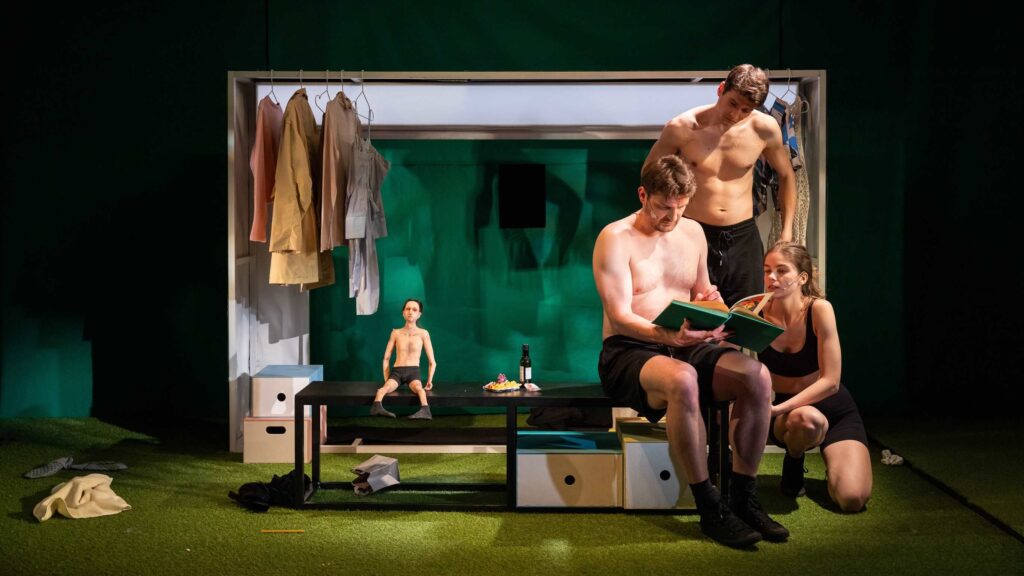National Kaunas Drama Theatre (NKDT) greets the centenary by reflecting the past - with his play “The Forerunners”, artistic director Gytis Padegimas brought back to stage the famous interwar personalities who contributed not only to the birth of professional theatre but to the formation of the common cultural landscape as well. Thanks to these personalities who make quite a long list (it would be a flaw not to mention someone while naming them all), we, I dare say, have an image of romanticized, intriguing interwar Kaunas which we pass on from generation to generation. Interwar Kaunas interests art and history researchers of different fields, as well as artists who, constantly looking back, reflect one or other aspect and present an unexpected, brave point of view. As an example, actors of Klaipėda Youth Theatre recently presented a project - a music album that contains a song titled “In Interwar Kaunas” which actualizes the status of a woman and marks out a feministic perspective.
Getting back to the centenary and “The Forerunners” which claims to become the centenary's symbol, it is important to note that it is a performance-investigation taking an important position along with other works of Padegimas which analyze personalities who left their mark in history (performance “J.A.H.” dedicated to the colorful personality of Juozapas Albinas Herbačiauskas, one of the first Lithuanian literature essayists; “Alksniškės” analyzing the controversial actions of Kazys Grinius, the last democratically elected interwar Lithuanian president).
“The Forerunners”, stepping on stage in 2020, is a tribute to the pioneers of Lithuanian drama theatre, as well as to the history as such. On December 19th, 1920, in then so-called Drama Acting Place (now it's called National Kaunas Drama Theatre, the name has been changed a dozen times throughout the years), artistic director Juozas Vaičkus (his personality inspired one of the leading characters in “The Forerunners”) staged a performance called “Fires of St. John” after a play by timely writer and dramatist Hermann Sudermann, and the space-time of the characters of the play was also pointing / looking back - the events take place in Lithuania Minor.
Throughout its existence, the National Kaunas Drama Theatre experienced different creative stages, explored various topics. All of the theatre seasons were concentrated more on history, as well as staging works of great classical authors. Other times, with the help of themes discussed in those works, using metaphors, Aesopic language, it was aspired to reflect the events and everyday life happening outside the walls of the theatre - the political and social situation of our country. All of this was supported by the search for a new, untried language of art. Uniting the historical line which becomes the dominating one in this particular text, further on it's suggested to overview the creations of a few authors whose works have been staged more than once in this theatre.
One of them is Norwegian playwright Henrik Ibsen whose plays were staged quite often on the stage of NKDT, some of the works counting several stagings. It is important to note that the very first staging of Ibsen's play took place in the same year as when the professional theatre started - on December 28th, 1920 his play “Ghosts” has been staged by artistic director Juozas Vaičkus. As Stasys Dobušis noted in his article, “the audience looked at the performance from already known Vaičkus' theatre performance's perspectives, and it was the only reason they enjoyed what they saw on stage as, in comparison with the older works, this performance showed big progress.” The reviewer tried to dissociate from this point of view, though, and value the performance more critically, paying attention to director's “aims” and “tasks”. This way, there was enough criticism not only for the director but also to all the company of young theatre actors. It's worth to mention that the critical articles after the premiers of that time were usually very literary and of brave critic view. In 2010, the same play at the same theatre was staged by a young generation's artistic director Artūras Areima, who was later associated with the image of a theatre rebel. The scenery of the performance, the images of the characters may testify the context of our times, though the dramaturgical material is being left quite unchanged, and the aforementioned interwar critic (who valued consistency) would probably be glad about it, when the modern theatrologist, always waiting for something new from the play or performance, would criticize it.
Almost after a year, in 1921, Ibsen's dramaturgy was staged again, this time by Konstantinas Glinskis who directed “Heda Gabler”. The performance received quite some attention in the press: one author stated that “Bielskaitė [actress Vida Bielskaitė] totally failed at depicting Heda. She performed her task all too shallow. Rude, awkward, languid - all she arose was only surprise. Particularly unbearable was the last act in which, before shooting herself, she went through so deep dynamic-wise scenes together with Brack so trivially and colorlessly.” Though despite lame acting aspects, there are some positive nuances as well - “In some episodes, she managed to convey so much using so few simple and concise measures, that the stage would fill with deep sense”.
After a long break, in 1998, this same play was premiered by artistic director Gintaras Varnas. As theatre critic Audronė Girdzijauskaitė later noted, „Everything that has been done later with Ibsen's works [after the aforementioned performance by Varnas] usually was mere post drama experiments created by the hands of talentless people. Those have been accidental stagings revealing the downfall of directing and theatre in general.” This particular performance by Varnas along with Heda Gabler's character created by actress Jūratė Onaitytė, positioned for years as a quality symbol of thoroughly investigated dramatical solutions and an evident masterly result on stage. The directing solutions, as well as acting, scenography, and the atmosphere of the performance, were highly appreciated. “<...> Set designer Jūratė Paulėkaitė turned the Long stage of the theatre into a white sterile shooting range where passionate hunter of souls Heda meets with her victims. From behind the partition, the audience watches Heda taking a gun into her hand and slowly aiming at live targets at the other side of the platform, wondering if she'll shoot or not.”
Having briefly discussed the stagings of “Ghosts” and “Heda Gabler”, we can see quite different positions of directors and theatre critics, but the decades that part these performances, links them with the same topics which are still relevant. Interwar directors aimed to work with these plays in the spirit of the playwright's primary prism, while the creators of our days tend to lean on the text of the play and contextualize it.
The second author whose staged plays are discussed further in this article is Max Frish and his “Biography: A Game”. This play concentrates on a human and the process of self-reflection which is relevant not only to an individual personality who rethinks itself but also can be understood in a wider sense. In this theatre, Frish's play was staged by Vytautas Čibiras in 1974. The performance was characteristic in realistic solutions, psychological acting, and sometimes being too dramatic in the conveying of the character. In 2014, director Gintaras Varnas took this same play and worked with it in a very different manner, constructing complex multifaceted characters on stage. It is important to note that during various historical times, professional Lithuanian theatre creators often needed to reflect on their personal biographies.
Continuing the theme of change, it is important to remember the theatre creators of nowadays as well, the ones who started their careers during the complicated Soviet times and contributed solidly to NKDT. These are artistic director Jonas Jurašas and playwright Aušra Marija Sluckaitė-Jurašienė. In 1971, Jurašas chose to stage Juozas Grušas' play “Barbora Radvilaitė” (about Lithuanian historic personality) in which actress Rūta Staliliūnaitė created one of the most important roles of her career. However, due to then existing Soviet regime and strict censorship, eventually, this performance became the reason why Jurašas had to leave Lithuania (he emigrated to the USA). After almost four decades, Jurašas and the playwright came back to accomplish their creative ideas once more staging “Barbora Radvilaitė” on the same stage of National Kaunas Drama Theatre. This time, Barbora's role was combined with the Actress's role and the task of implementing it on stage was entrusted to actress Eglė Mikulionytė. This second staging received controversial appreciation in media, but the history of its staging which includes several decades, different regimes, changed creative opportunities and solutions, became yet another subject of researching. One of the proofs is a 2017 film “Emilia” by Donatas Ulvydas which tells a story about unrest in Kaunas in 1972, and the story of the main characters is more than just an allusion to the aforementioned duo of theatre creators.
National Kaunas Drama Theatre distinguishes itself in different attributes and one of them, I dare say, is (self)reflecting: in the sight of changing political regimes, while choosing the same dramaturgical material, different directors directly or not reflect on the previous works of their colleagues-directors, as well as on creative solutions, rethinking circumstances and the context, and this shows in other creators works one way or another, establishing a connection with the creations of their predecessors or, as it is chosen to say in the title of the performance created for the centenary - their forerunners.
APAC info













